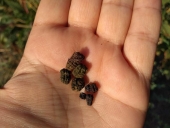





 1
1












Our inability to change everything should not stop us from changing what we can.
























mrchuck wrote:
I think its good we're being honest about the fact that though as unsustainable and degrading as it is, modern methods of corn production, are... pretty productive.
But that's also Monsanto's argument, that we need their corn to "feed the world". That argument is so flawed its ridiculous.
Mollison says that we probably only have like a good 30 years left of the phosphorous supply at this rate of production, so that right there should end these crazy yields. But if it doesn't, one of the other thousand problems of industrial ag will end it.
Remember pesticides have only been in heavy use for less than 50 years, a tiny tiny fraction of human history, 1/5 of US history, and probably 1/100 of the history of North America inhabited by humans.




Emerson White wrote:
We do have lower grade phosphorous supplies that will last for at least 200 years given our current acceleration of use of phosphorous, it'll just cost more to ship it.









 1
1




Anonymous wrote:we see basically the same curve in Rice and Wheat.
with a lag time of just a few years, Central and South American Nations, India and China and many SE Asian Nations, also see the same sort of tangential rise... in human population.
it should be noted that this is quantity of lives, not quality of life.
behind monsanto you will find cymmit: http://www.cimmyt.org/




If there is one thing the Wizard of Oz has taught me, it is not to trust school teachers on bicycles.





|
It's just a flesh wound! Or a tiny ad:
The new gardening playing cards kickstarter is now live!
https://www.kickstarter.com/projects/paulwheaton/garden-cards
|









